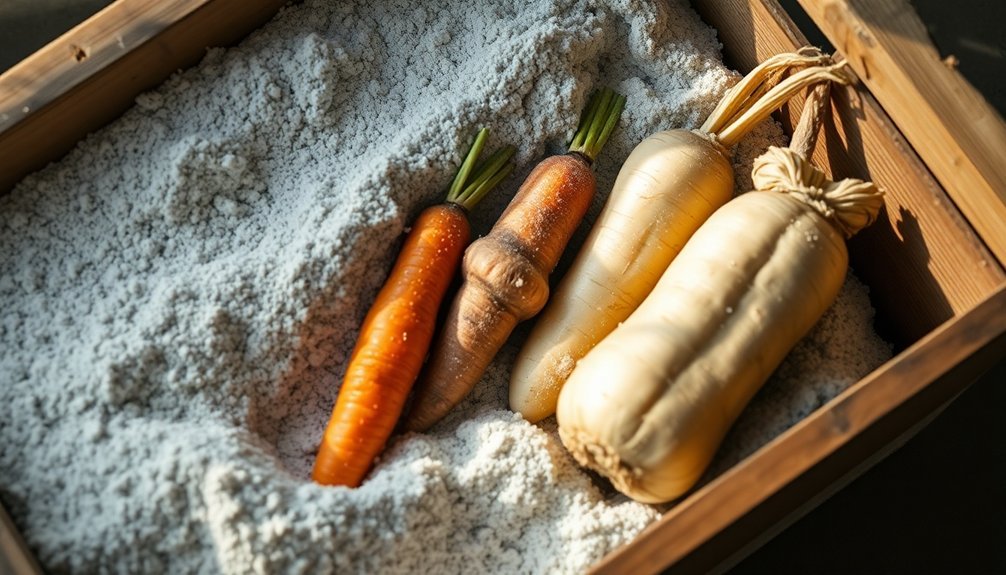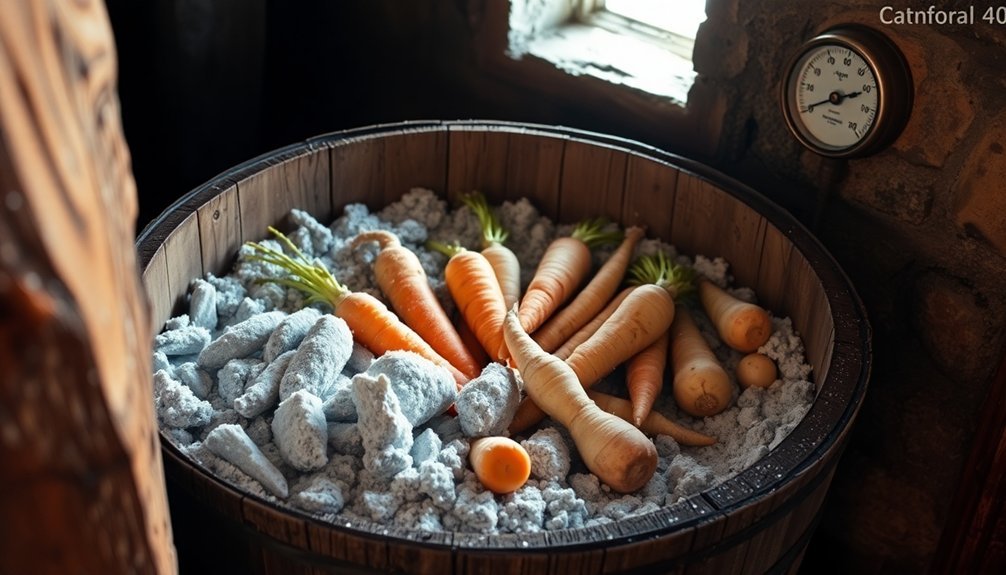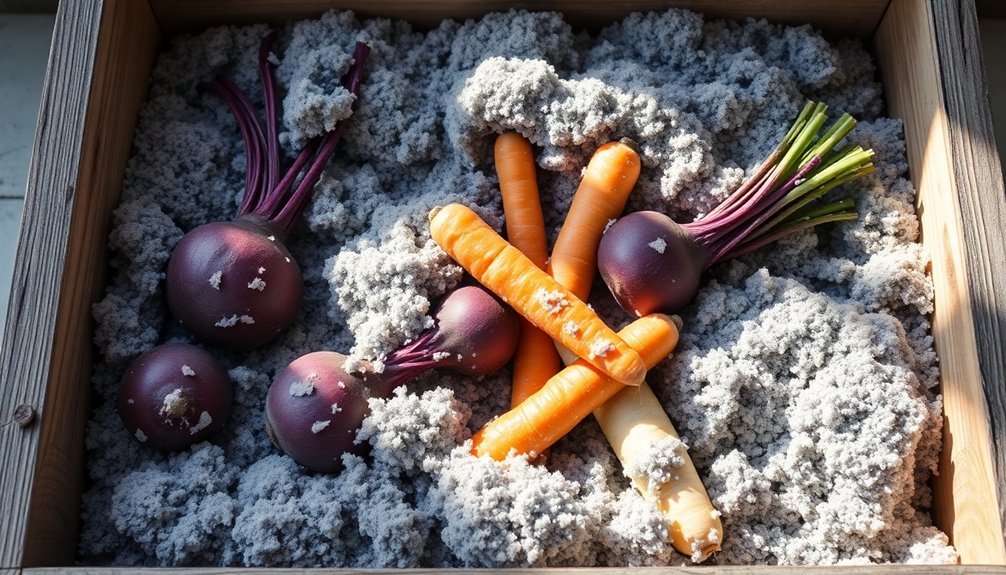Wood ash storage extends your root vegetables' shelf life from months to years while naturally protecting against pests and spoilage. You'll benefit from wood ash's high pH and antibacterial properties that preserve nutritional value by preventing moisture loss and air exposure. It's a cost-effective solution that doesn't require refrigeration, as the ash creates ideal cool, dark conditions for storage. The ash's potassium content aids preservation while preventing fungal growth and absorbing ethylene gas that causes premature ripening. By following proper storage techniques, you'll discover how this traditional method can transform your vegetable preservation game.
Benefits of Wood Ash Storage

Storing root vegetables in wood ash offers several remarkable advantages that make it a time-tested preservation method. You'll find that wood ash acts as a natural pest deterrent, keeping both insects and rodents away from your stored vegetables. This protection is essential in areas where pest infestations can quickly destroy your harvest.
When you use wood ash storage, you're extending your vegetables' shelf life considerably. The high pH of wood ash provides antibacterial properties that prevent spoilage and decay. Your produce can last from three months to several years, as the ash creates an ideal environment that slows down biological processes. The cool, dark conditions help maintain freshness throughout extended storage periods.
You'll also preserve more nutritional value in your vegetables when using wood ash. The ash layer prevents moisture loss and protects against air exposure, ensuring your vegetables stay juicy and nutrient-rich. The method doesn't introduce any harmful substances that could compromise the food's nutritional content.
What's more, you'll appreciate how cost-effective this storage solution is. If you have a wood-burning stove or fireplace, you've got easy access to ash. You won't need expensive storage equipment or electricity for refrigeration, making it particularly valuable in areas with limited resources.
Proper Storage Setup Methods
Three essential steps form the foundation of a proper wood ash storage setup for your root vegetables.
First, you'll need to select and prepare appropriate containers. Choose wooden boxes, cardboard containers, or woven baskets, and line them with paper. Make sure they're clean, dry, and haven't been exposed to chemicals. The containers should have covers or seals to maintain ideal conditions.
Next, prepare your wood ash correctly. Collect cool ash from wood fires and sift it thoroughly to remove any debris or sharp particles. Avoid using ash from treated timber as it contains harmful residues. You'll want to create alternating layers, starting with a 1.5-inch ash base. Place your vegetables in layers, covering each with ash, and finish with an ash layer on top to protect against moisture.
Finally, establish proper storage conditions. Position your containers in a cool, dry space with temperatures between 32°F and 40°F. Keep them elevated off the ground to improve airflow and reduce condensation.
You'll need to monitor your storage regularly, checking for signs of spoilage and maintaining appropriate humidity levels. If you notice the ash becoming damp, reapply a fresh layer to maintain effective preservation.
Best Vegetables for Ash Storage

Not every vegetable thrives in wood ash storage, and knowing which ones do can save you time and prevent waste.
If you're looking to experiment with ash storage, tomatoes are your best option. You can store newly picked, ripe tomatoes in wood ash for up to three months, making it an excellent method for winter storage. While the skin may wrinkle, the pulp remains juicy as long as you select unblemished tomatoes without soft spots.
You'll want to avoid storing root vegetables like potatoes, carrots, and onions in wood ash, despite what you might've heard. These vegetables need specific temperature and humidity conditions, and they'll store better in underground pits, unheated cellars, or under organic materials like sawdust or straw. Since wood ash is a powerful soil pH regulator, improper storage could affect vegetable quality.
Potatoes, in particular, shouldn't be stored in ash because the alkaline conditions can promote potato scab.
Don't attempt to store acid-loving plants or vegetables sensitive to high pH levels in wood ash. Instead, focus on traditional storage methods for these items.
While ash storage offers a unique solution for tomatoes, it's not a one-size-fits-all approach to vegetable preservation.
Safety Tips When Using Ash
When storing root vegetables in wood ash, you'll need proper protective gear, including gloves, long sleeves, and a face mask to prevent skin contact and dust inhalation.
Make sure you're using only cooled ash from untreated hardwoods, avoiding any ash from treated lumber, coal, or synthetic materials.
You'll also want to handle the ash in a well-ventilated area and store it in covered metal containers away from combustible surfaces.
Protective Gear Requirements
Safe handling of wood ash requires proper protective equipment to shield your body from potential hazards. You'll need to protect your eyes, skin, and respiratory system when working with ash for vegetable storage. Always wear goggles or safety glasses with a proper seal to keep ash particles from entering your eyes, and choose anti-fog coated eyewear for better visibility.
When it comes to skin protection, you'll want to cover up completely. Wear long sleeves, pants, closed-toe shoes, and gloves. Don't forget to protect your face with a mask or bandana, and apply moisturizer after handling ash to prevent skin irritation.
| Body Part | Protection Needed | Maintenance |
|---|---|---|
| Eyes | Sealed goggles/glasses | Replace if damaged |
| Skin | Long clothes, gloves | Wash after use |
| Lungs | N95 mask/respirator | Replace when clogged |
| Head | Hat and scarf | Clean regularly |
| Hands | Chemical-resistant gloves | Check for tears |
For respiratory safety, you'll need an N95 mask or higher-rated respirator that fits snugly. Work in well-ventilated areas and take breaks to breathe fresh air. Clean up any spills with a damp cloth or small vacuum rather than sweeping to minimize airborne particles.
Safe Handling Guidelines
Proper handling techniques complement your protective gear when working with wood ash for vegetable storage.
You'll need to verify your ash source is safe by avoiding ash from treated timber, coal, or anthracite, as these contain harmful residues that can contaminate your stored vegetables.
When handling ash, always store it outdoors on a cement or brick surface, keeping it at least three feet away from any combustible materials.
Don't place ash containers on wooden surfaces like decks or porches. Use only metal containers with secure covers to prevent wind dispersal and moisture penetration, as rain can cause nutrient leaching.
Before using ash for storage, you'll need to confirm it's completely cold, waiting at least a month after removing it from the stove.
Only work with ash on calm days to prevent it from blowing into your face or spreading uncontrollably.
When preparing your storage area, mix the ash thoroughly to eliminate any hidden hot spots or buried embers that could pose a fire risk.
If you're incorporating ash into your soil later, remember to test your soil's pH levels every few years, as wood ash can greatly increase alkalinity.
Temperature and Humidity Control

You'll need a constant temperature between 32° and 40°F to create a stable storage environment for your root vegetables in wood ash.
While wood ash itself won't control temperature, placing your storage containers in a cool, dark location with proper insulation and monitoring thermometers will help maintain these ideal conditions.
Maintaining humidity levels between 80-95% is essential, which you can achieve by using a dirt floor or placing water pans in your storage area, though you'll want to make sure the wood ash itself stays dry to remain effective.
Stable Storage Environment
Within a successful root vegetable storage system, maintaining stable temperature and humidity levels is essential for long-term preservation. You'll find that wood ash creates an ideal environment by regulating both factors simultaneously. When you layer wood ash properly, it acts as an insulating barrier that keeps temperatures between 32°F and 40°F, while maintaining humidity levels above 70%.
| Storage Factor | Wood Ash Function | Benefit |
|---|---|---|
| Temperature | Insulating layer | Prevents freezing and warming |
| Humidity | Moisture barrier | Reduces dehydration |
| Light | Coverage layer | Blocks photosynthesis |
| Physical | Protective barrier | Prevents pest damage |
| Separation | Layering medium | Minimizes rot spread |
Perfect Moisture Balance
Maintaining the perfect moisture balance in and around your root vegetables requires careful attention to both temperature and humidity levels. You'll want to keep your storage area between 32° and 40°F to slow down vegetable metabolism and preserve freshness. This temperature range is essential for long-term storage success.
Your storage space needs to maintain 80-95% relative humidity to prevent your vegetables from drying out. If you're using a root cellar, you'll benefit from a dirt floor that naturally maintains moisture levels. For concrete or wooden floors, you can place water pans to increase humidity. Remember, a fuller cellar typically means better humidity control.
While wood ash doesn't directly control temperature or humidity, it plays a specific role in moisture management. When you're storing certain vegetables like tomatoes, the ash acts as a desiccant, creating a protective dry environment that prevents mold growth.
You can enhance this effect by combining wood ash with materials like sawdust or sand. For best results, sift the ash to remove sharp particles and layer it carefully with your vegetables to maintain the right moisture balance throughout storage.
Long Term Preservation Strategy
For successful long-term storage of root vegetables in wood ash, proper environmental control and preparation are essential. You'll need to maintain a cool, dry storage area with stable temperatures and protect your vegetables from light exposure. Using insulating materials like hay or straw helps regulate both temperature and humidity levels effectively.
When selecting vegetables for storage, choose undamaged specimens harvested from dry soil late in the fall. You'll want to clean them gently and guarantee they're varieties known for their storage qualities. Don't store them near fruits like apples, which release ripening gases that can spoil your vegetables prematurely.
Your storage method should utilize underground facilities or insulated pits. Layer your vegetables in wood ash within cardboard or wooden boxes, as ash's alkaline properties help balance pH levels and control moisture. The ash also absorbs ethylene gas, which slows down the ripening process.
You'll need to check your stored vegetables regularly to remove any that show signs of rot.
Remember that wood ash isn't just a storage medium – it's rich in potassium and helps prevent fungal growth, making it an excellent choice for long-term vegetable preservation.
Common Wood Ash Storage Mistakes

Several critical mistakes can derail your wood ash storage efforts. Using the wrong type of ash is perhaps the most serious error – you'll want to avoid ash from treated timber, coal, or any source other than clean wood fires.
If you're using ash from outdoor bonfires, make sure it hasn't been exposed to rain, as this strips away valuable nutrients that help preserve your vegetables.
Here's what you need to watch out for when preparing your storage system:
- Using unsifted ash that contains debris and sharp particles, which can damage your vegetables.
- Failing to guarantee the ash is completely cool and dry before use, which can lead to moisture problems.
- Not wearing proper protective gear during handling, exposing yourself to respiratory risks.
When you're setting up your storage, don't make the mistake of using too much ash – you're not trying to change the soil pH here.
Instead, focus on creating even layers between your vegetables. You'll also want to avoid using ash that's been sitting in high-moisture areas or mixing in ash from charcoal briquettes, as these can introduce unwanted chemicals to your stored produce.
Frequently Asked Questions
Can Wood Ash From a BBQ Grill Be Used for Vegetable Storage?
You can use BBQ grill ash from lumpwood charcoal for vegetable storage, but you'll need to guarantee it's free from chemicals and contaminants. Don't use ash from briquettes or treated wood.
How Often Should Wood Ash Be Replaced During Long-Term Storage?
You should replace wood ash every 4-6 weeks during storage, or sooner if you notice moisture buildup. Check the ash regularly and change it when it feels damp to maintain effective preservation.
Will Vegetables Stored in Wood Ash Have an Ashy Taste?
You don't need to worry about an ashy taste. Vegetables aren't typically stored directly in wood ash – it's mainly used for soil enrichment. When properly stored in sawdust or other materials, they'll maintain their natural flavor.
Can Wood Ash Storage Methods Be Combined With Refrigeration?
You won't need to combine wood ash with refrigeration. It's redundant since your fridge already controls temperature and humidity. If you're using refrigeration, you can skip the wood ash storage method entirely.
Does the Type of Wood Used for Ash Affect Storage Effectiveness?
Yes, the type of wood affects storage effectiveness. You'll get better results using hardwood ash, as it contains more nutrients and minerals than softwood ash. It's also more consistent in its preservation properties.
In Summary
Storing root vegetables in wood ash provides you with an effective traditional preservation method. You'll find it helps maintain ideal moisture levels while preventing rot and pest infestations. When you follow proper setup methods and safety guidelines, you can greatly extend your vegetables' shelf life. Just remember to use clean, dry ash and monitor temperature conditions regularly. With these steps, you'll successfully preserve your root vegetables throughout the season.





Leave a Reply